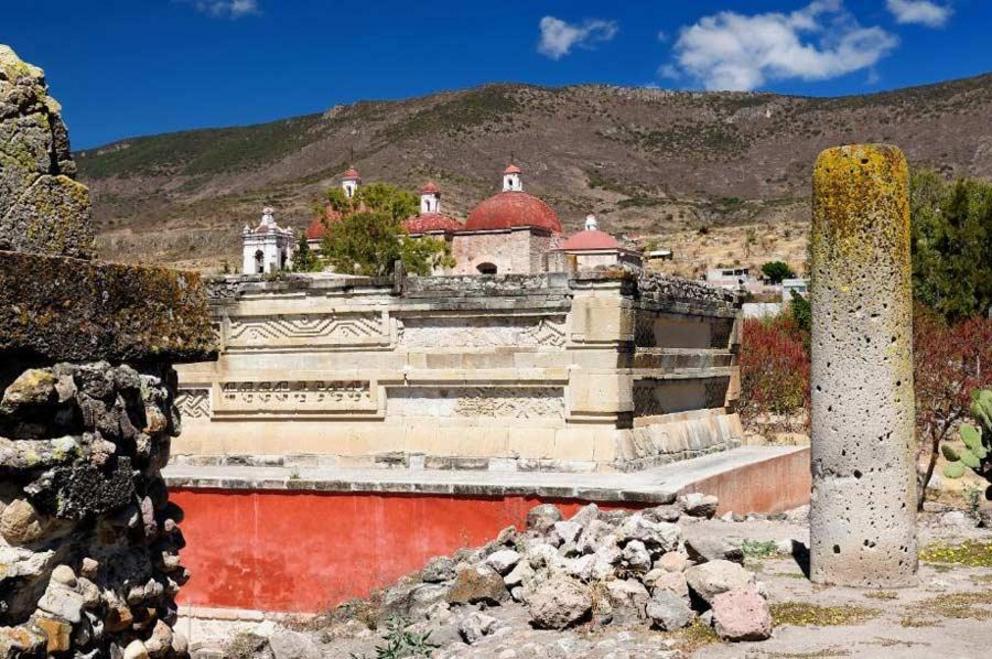Searching for the lost subterranean worlds of Mitla, Mexico
Top image: The amazing ruins of Mitla and the San Pablo Church Domes, where high technology is being used to discover the truth behind the legends of subterranean Mitla
Ancient and colonial sources speak of an extensive underground labyrinth of caves and tunnels, considered by the ancient Zapotec to be a physical entrance into the Underworld of Lyobaa, located under the ancient site of Mitla, Mexico. A new research project now aims to reveal the secrets of the Mitla Underworld using the latest, state-of-the-art geophysical equipment.
Discovering Mitla
The archaeological site of Mitla, located in the Central Valley of Oaxaca , is among the most famous and best preserved in all of Mexico.
The first permanent human occupation of the area dates to 8,000 BC and is associated with the earliest evidence of crop domestication in the Americas .
Mitla reached its greatest splendor in the post-classic period, around 1,200 AD, and was already an important city in the classic period (ca. 100-650 AD). Five main groups of structures have been explored and documented at the site of Mitla.
The Columns Group, Church Group and Arroyo Group are the best preserved and share similar characteristics, including the use of large megalithic stone blocks for construction, as well as the mosaic decoration of their façades.
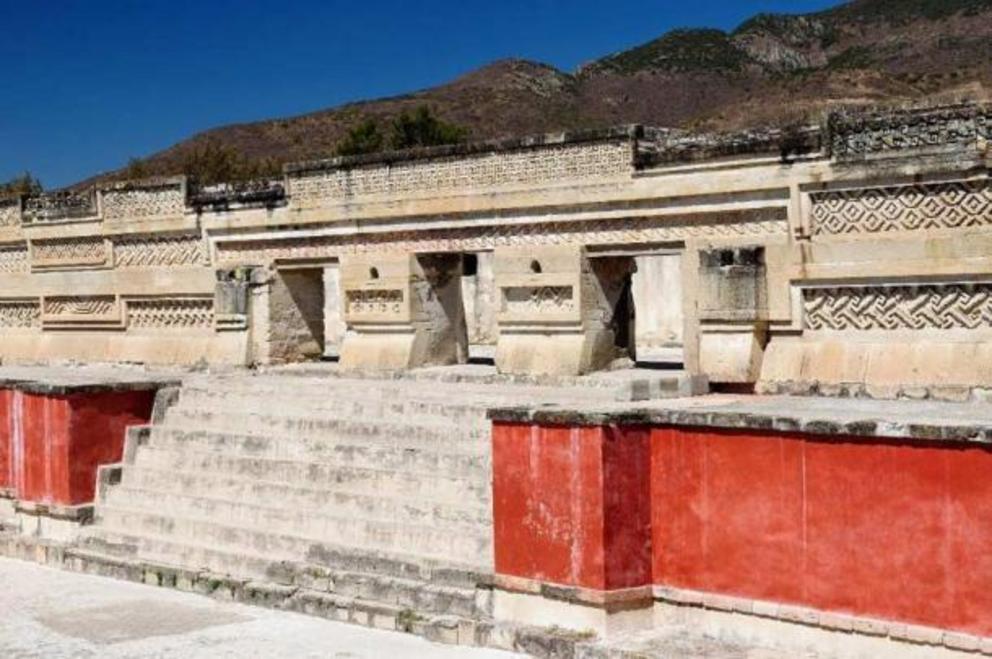 Giant stone blocks and intricate reliefs are found in many structures at Mitla.
Giant stone blocks and intricate reliefs are found in many structures at Mitla.
Some of the monolithic lintels employed in the palaces, particularly the “Columns Group,” measure as much as 6 meters (20 feet) long, with an estimated weight of more than of 30 tons (27,216 kilograms). Monolithic columns, each over 5 meters (16 feet) tall, were also used to support the roof of some of the palaces. The walls of the buildings were then lined with beautiful and exceedingly intricate stone mosaics, perhaps in the imitation of textiles. Hundreds of perfectly cut, polished and fitted stones were employed for the realization of each mosaic panel. In some cases, the walls were painted in what archaeologists have labelled as “ Codex style ,” for its similarity with the coeval Mixtec codices and manuscripts.
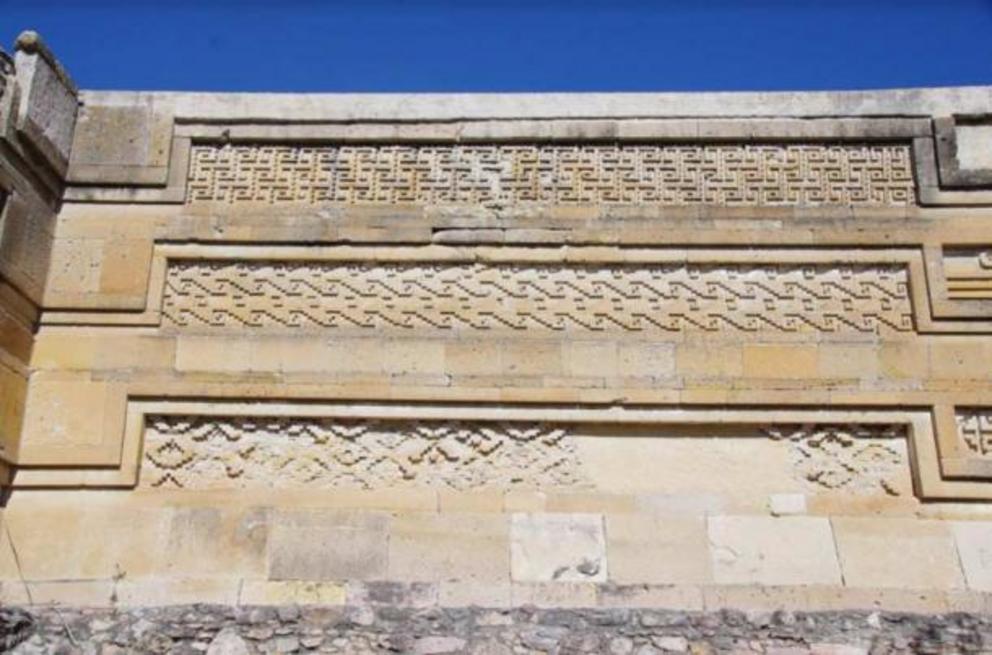 A closeup of some of the intricate stone mosaics that decorate the outer walls of the “Columns Group.” One also notices the extreme quality of the stone workmanship and the remarkable state of preservation of these pre-Hispanic structures at Mitla.
A closeup of some of the intricate stone mosaics that decorate the outer walls of the “Columns Group.” One also notices the extreme quality of the stone workmanship and the remarkable state of preservation of these pre-Hispanic structures at Mitla.
The Lost Underworld of Mitla
Some exceptionally finely constructed and decorated subterranean chambers existed underneath the palaces of Mitla, being likely the tombs of priests and kings. These chambers generally followed a cruciform plan , with four long arms departing from the center. Each chamber was partially dug out of the solid bedrock, and then lined with enormous blocks of stone to form the walls and ceiling.
Similar megalithic chambers are also found around Mitla, at Guirún and Xaagá. The cruciform chamber of Guirún, in particular, was built of immense, perfectly carved stone blocks, the largest weight over 50 tons (45,359 kilograms).
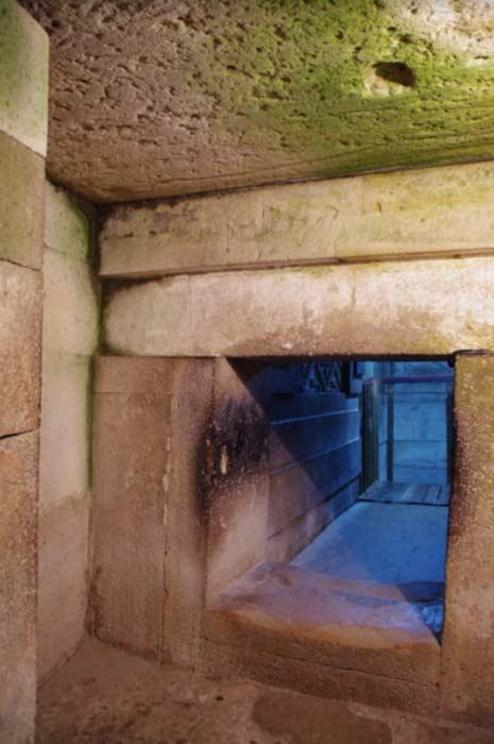 One of the subterranean chambers of the “Columns group.” Note the enormous size and the perfect fitting of the monolithic lintel above the entrance, and the immense monolithic slab forming the roof of the chamber.
One of the subterranean chambers of the “Columns group.” Note the enormous size and the perfect fitting of the monolithic lintel above the entrance, and the immense monolithic slab forming the roof of the chamber.
The reason for the great importance of Mitla in ancient times seems to have been the presence underneath the site of a vast cave system , which the Zapotecs considered to be a physical entrance to the Underworld, which they called Lyobaa.
Immense subterranean chambers passages running in many directions like streets and hallways supported by columns are described in 16th and 17th century Spanish accounts.
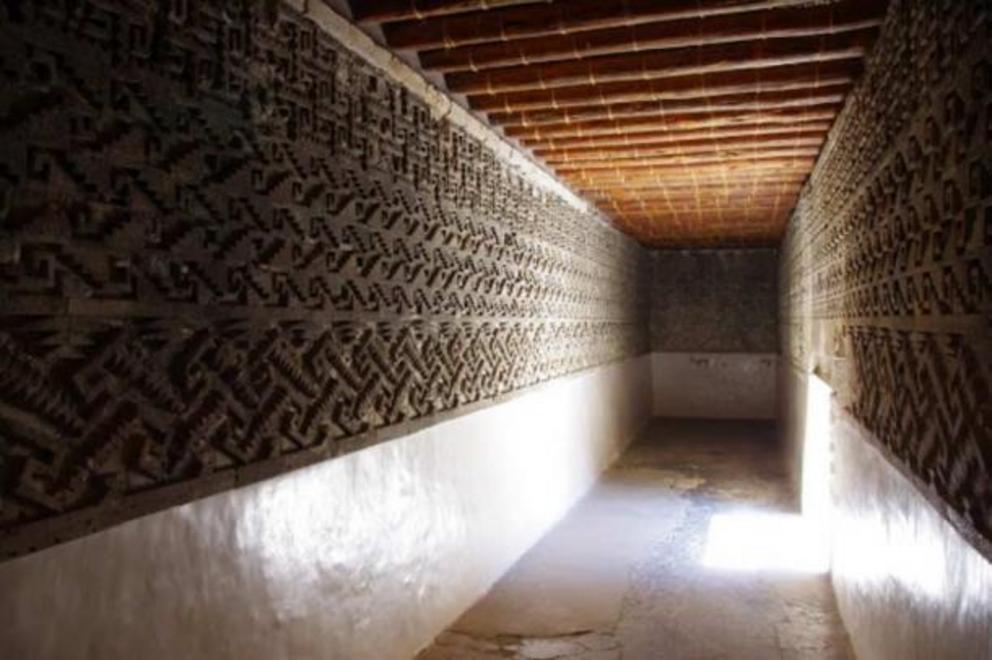 A view into one of the side chambers of the Mitla “Columns Group,” showing more of the intricate mosaics and sculpted decoration on the inner walls.
A view into one of the side chambers of the Mitla “Columns Group,” showing more of the intricate mosaics and sculpted decoration on the inner walls.
In the 17th century, the Dominican father and inquisitor Francisco de Burgoa, left what is perhaps the most complete account of the subterranean labyrinth of Mitla:
“The last (underground) chamber had a second door at the rear, which led to a dark and gruesome room. This was closed with a stone slab, which occupied the whole entrance. Through this door they, threw the bodies of the victims and of the great lords and chieftains who had fallen in battle…and so great was the barbarous infatuation of those Indians that, in the belief of the happy life which awaited them, many who were oppressed by diseases or hardships begged this infamous priest to accept them as living sacrifices and allow them to enter through that portal and roam about in the dark interior of the mountain, to seek the feasting-places of their forefathers. […] And the unhappy man, wandering in that abyss of darkness, died of hunger and thirst, beginning already in life the pain of his damnation, and on account of this horrible abyss they called this village Liyobaa .”
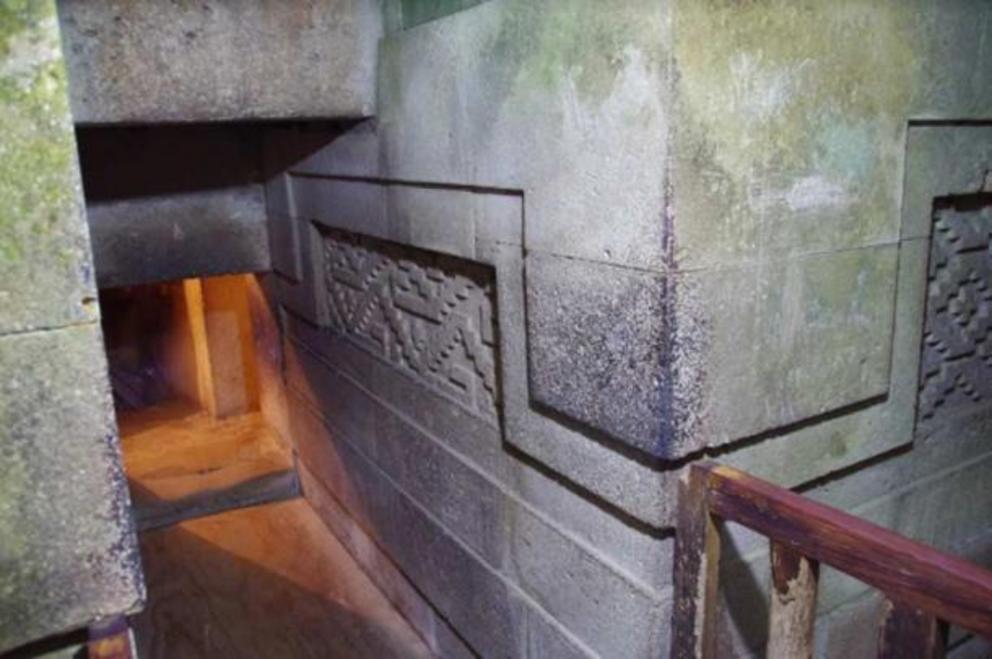 The entrance to one of the subterranean chambers of the “Columns group.” Note the giant size and the perfect fitting of the monolithic lintel above the entrance, and the huge monolithic slab forming the roof of the chamber.
The entrance to one of the subterranean chambers of the “Columns group.” Note the giant size and the perfect fitting of the monolithic lintel above the entrance, and the huge monolithic slab forming the roof of the chamber.
“When later there fell upon these people the light of the Gospel, its servants took much trouble to instruct them, and to find out whether this error, common to all these nations, still prevailed; and they learned from the stories which had been handed down that all were convinced that this damp cavern extended more than thirty leagues underground, and that its roof was supported by pillars. And there were people, zealous prelates anxious for knowledge, who, in order to convince these ignorant people of their error, went into this cave accompanied by a large number of people bearing lighted torches and firebrands, and descended several large steps. And they soon came upon many great buttresses which formed a kind of street. They had prudently brought a quantity of rope with them to use as guiding-lines, that they might not lose themselves in this confusing labyrinth. And the putrefaction and the bad odour and the dampness of the earth were very great, and there was also a cold wind which blew out their torches. And after they had gone a short distance, fearing to be overpowered by the stench, or to step on poisonous reptiles, of which some had been seen, they resolved to go out again, and to completely wall up this back door of hell.
The four buildings above ground were the only ones which still remained open, and they had a court and chambers like those underground; and the ruins of these have lasted even to the present day ” [ Geographica Descripción , 1681]
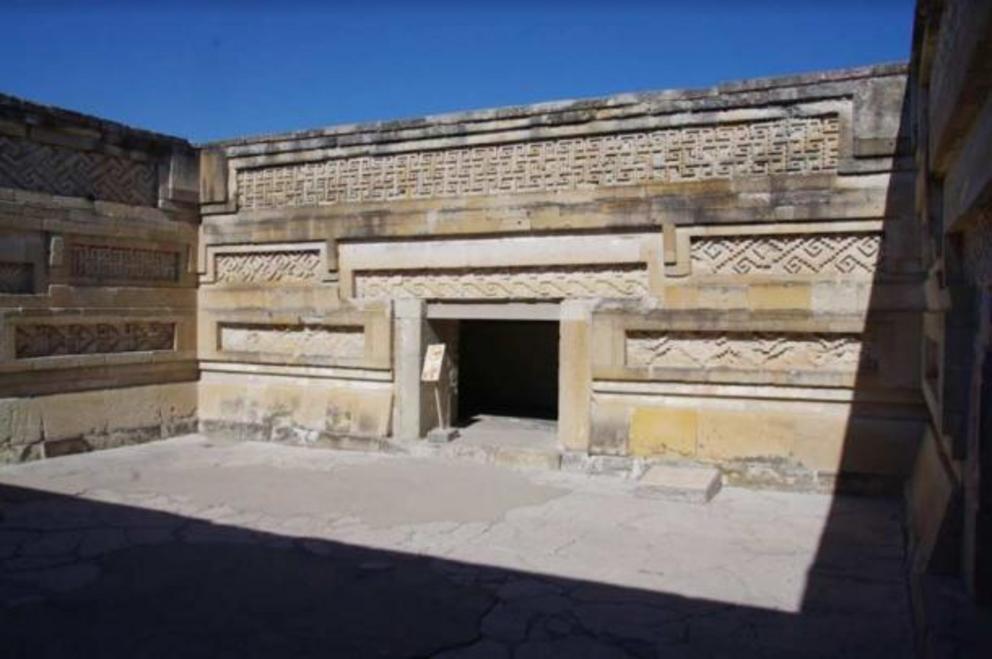 Some of the delicate carvings and stone mosaics framing a doorway inside the “Columns Group.” The mosaic decoration was probably an imitation of textile designs and was originally painted in bright colors of which only faint traces remain.
Some of the delicate carvings and stone mosaics framing a doorway inside the “Columns Group.” The mosaic decoration was probably an imitation of textile designs and was originally painted in bright colors of which only faint traces remain.
All entrances to the underground labyrinth were allegedly sealed when a church was erected on the site in the late 16th century, partly reusing walls and stones from the ancient ruins.
Attempts made in the 19th and 20th century to locate the lost labyrinth led to the discovery of at least two monumental tombs underneath one of the patios of the Columns Group, yet most of the site, and particularly the Church Group, remained largely unexplored.
Project Lyobaa
Project Lyobaa now aims to uncover the secrets of the Mitla Underworld by looking for possible subterranean cavities underneath the Church and the Columns Group.
The project is the result of an institutional collaboration and partnership between the Mexican National Institute of History and Anthropology (INAH), the National Autonomous University of Mexico (UNAM), and the ARX Association for Archaeological Research and Exploration (ARX Project, A.C.).
Employing the latest technologies and state-of-the art geophysical equipment, Project Lyobaa aims to reveal the truth beneath the subterranean Mitla legend through a combination of three different geophysical prospection techniques that will allow us to literally see below the ground without the need for potentially destructive excavations.
The techniques proposed for this project include the use of Ground Penetrating Radar (GPR) , Electrical Resistivity Tomography (ERT) and Seismic Noise Refraction Tomography, all of which have been already successfully employed at other important Mexican archaeological sites such as Teotihuacan and Chichen Itzá.
In a first phase, research will focus on the so-called Church Group and the Columns Group, being the most important and best preserved of the ancient palaces of Mitla. In a second phase, the research could then be extended to include some of the other groups of structures at Mitla.
The ARX Association has now launched a fundraising campaign with the aim to cover the remaining 15,000 dollars (13,480 euros) required to fully fund the project by April 15th, 2022.
With your donation you will be helping to reveal the secrets of one of the most important archaeological sites in all of Mexico that has the potential of bringing forth a new understanding of the origins of Mesoamerican civilization.

